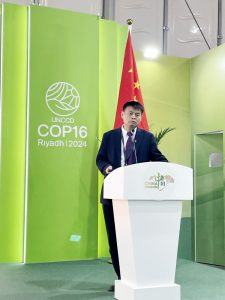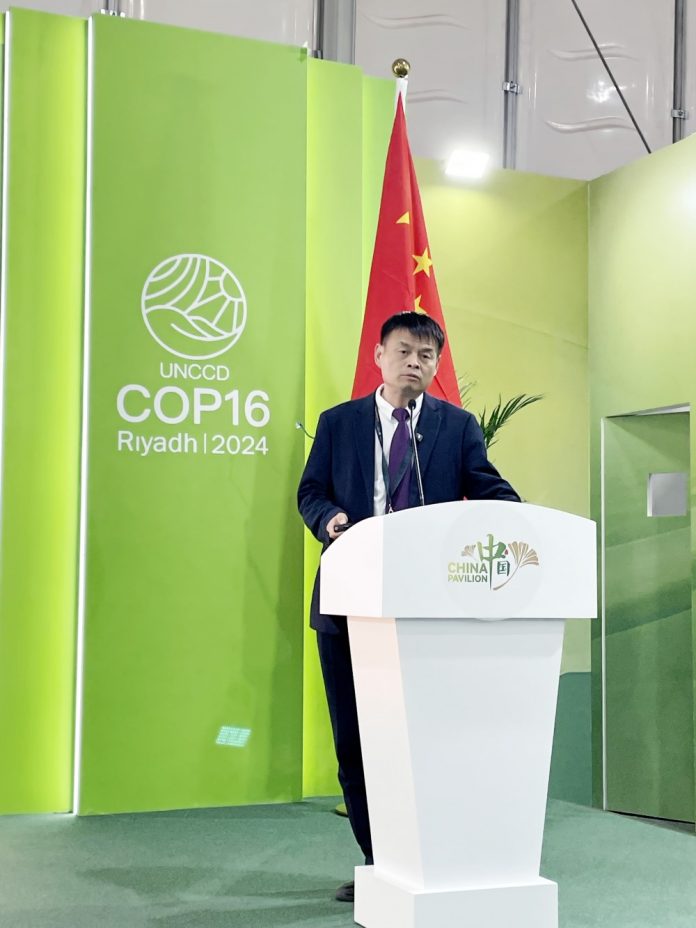[International Energy Network, Live Report] The China-Middle East Desert Rose and Greening Industry Seminar was held as part of a series of side events at the China Pavilion of COP16 on the morning of December 5 in Riyadh, Saudi Arabia. Wang Fuzhou, Chairman and R&D chief engineer of Zhengsai Group, delivered a speech entitled “Zhengsai desert tree planting new technology”.

Wang Fuzhou, Chairman and R&D chief engineer of Zhengsai Group
During the session, Wang Fuzhou shared his years of experience in planting trees in deserts. Wang emphasized that Zhengsai’s desert water-retaining and leakage-reducing breathable technology can save 50%-70% more water than traditional drip irrigation, achieving maximum green spaces with minimal freshwater use.
Traditional Desert Planting Faces Many Challenges and Difficulties
At the beginning of his speech, Wang Fuzhou introduced the difficulties of planting in deserts. Desert areas typically experience extreme climates such as high temperatures, intense sunlight, large temperature differences between day and night, drought, and scant rainfall. High temperatures and intense sunlight accelerate water evaporation and drought, leading to extreme water scarcity, which makes it difficult for saplings to survive. Desert soil lacks nutrients, has a loose structure, and poor water and fertilizer retention capabilities, which are not conducive to the growth and development of plant roots. Frequent wind and sand activities can bury saplings, destroy the plant growth environment, and even blow down or break saplings directly. Obtaining sufficient and stable irrigation water in deserts is a major challenge. Long-distance water transfer is costly, and local water extraction often faces issues of limited groundwater resources and poor water quality.
In addition to the impact of desert conditions, traditional watering and irrigation methods for planting trees in deserts can consume large amounts of precious water resources in desert areas, and water utilization rates are often not high, which can easily lead to waste. Continuous monitoring, watering, fertilization, pest control, and other maintenance work require human, material, and financial resources. The tree species chosen may adapt to desert environments in the short term, but from a long-term and ecological system perspective, their ecological adaptability and contribution to ecological balance may be limited. Traditional planting methods may be difficult to fundamentally improve the structure and poor nutrient status of deserts. Due to resource and technological limitations, traditional planting methods have certain limitations in terms of large-scale promotion and rapid improvement of desert environments.
Wang Fuzhou stated that traditional desert planting practices have shortcomings such as high water consumption, high maintenance costs, limited ecological adaptability, insignificant soil improvement effects, and limited scale and speed.
Zhengsai Develops New Desertification Control and Improvement Technology
To address the immense challenge of desertification, Zhengsai Group has developed a new desertification control and improvement technology, namely, deep water storage and permeable water-reducing gas-impermeable technology. This technology sets up a water-storing permeable and gas-impermeable “isolation layer” at a certain depth in the desert, which can effectively reduce water infiltration and enable water to be retained around plant roots for an extended period to meet the needs of plant growth.
Compared to traditional technologies:
Investment Costs: In the short term, the initial investment for the new technology is relatively high, while the initial investment for traditional planting methods seems lower. In the long term, the new technology has lower costs, achieving “century-long protection” with construction. Traditional methods have high long-term operation and maintenance costs, requiring frequent repairs and improvements.
Resource Utilization: The new technology can collect rain and sleet water, saving resources and reducing dependence on external water sources. Traditional planting relies on external water sources, leading to high water consumption and low utilization efficiency.
Maintenance Costs: The later-stage maintenance cost of the new technology is very low, almost negligible. Traditional planting methods require continuous investment of human and material resources for maintenance, keeping costs high.
Soil Improvement: (Note: This point was repeated; the second mention should be omitted or replaced with additional information.)
Ecosystem Creation: The new technology can create new ecosystems and contribute to the overall effectiveness of desert governance, while traditional farming methods have a relatively weaker effect.
Overall, this new planting technology has great development potential and broad application prospects.
Demonstrating New Desert Planting Technology with Excellent Results
The new desert planting technology has significant advantages, and Zhengsai Restoration has achieved remarkable results through years of industry practice. The Tengger Desert Governance Demonstration Area, with a north-south length of 240 kilometers, an east-west width of 160 kilometers, and a total area of about 43, 000 square kilometers, is dominated by mobile dunes and is the fastest-moving desert in China. Zhengsai Group established a desert oasis demonstration project in the Tengger Desert in 2023. Initially, there was only one grass here; after careful treatment with Zhengsai Restoration’s water-saving technology, it turned into grassland in the spring of 2024. Besides facilitating grass growth, the trees planted using Zhengsai Restoration technology can grow to over 3 meters tall in two years.
The Zhengsai Geospatial Ecological Restoration Innovation Demonstration Base combines rainwater harvesting ponds, windbreak and sand prevention, breathable ponds, and planting to form an ecological cycle. It has cultivated desert corn, desert potatoes, improved desert grass, desert watermelons, and other crops. The products grown are free of insect holes and pesticides, making them ecologically friendly and environmentally protected.
According to food safety inspection reports, the pesticide residue and heavy metal content of sandy soil and various desert ingredients meet food safety standards.
Wang Fuzhou stated that Zhengsai Restoration’s project bases have attracted numerous visits from domestic academician teams, industry experts, and media websites. Professor Zhao Liangjun from China Agricultural University and Frank, Chairman of Zhengsai Group, personally picked watermelons and held a watermelon tasting event at the site.
A High-Tech Enterprise Providing Comprehensive Solutions with Water Management as Core Technology
Zhengsai Restoration’s impressive achievements are inseparable from its strength. Zhengzhou Sino Building Materials Co., Ltd., founded in 2007, is a high-tech enterprise focused on scientific research and technological innovation. Its team is composed of personnel with technical backgrounds from European and American multinational companies, standing at the international forefront and specializing in collaborative research and governance of water hazards, sand hazards, and solid waste. It has obtained nearly 30 invention and utility model patents, published dozens of domestic and international academic papers, edited and co-edited over 20 national standards and specifications, and achieved 6 world-leading results, filling market gaps. With high cost-effectiveness, it has solved problems in the fields of environmental governance and engineering construction, earning high recognition from society and industry insiders.
The desertification control technology adopts advanced redundant protective water-retaining and water-saving technology, reducing groundwater consumption by about 70% compared to traditional drip irrigation. It achieves ecological sustainable development and harmonious coexistence between humans and nature. The rocky desertification control adopts advanced redundant protective soil and water conservation technology, which can convert severely rocky desertified mountainous dry farmland into paddy fields or fertile farmland with high quality, slowing down the environmental and ecological damage caused by rocky desertification and water and soil loss. Red mud comprehensive utilization employs redundant waterproof technology, significantly improving the waterproof quality and durability of engineering while shortening the construction period and providing high cost-effectiveness. Wang Fuzhou stated that many of Zhengsai Restoration’s technologies have been assessed as internationally advanced by the Chinese Ministry of Science and Technology.
At the end of his speech, Wang Fuzhou said that the company has already established a branch in the Philippines and plans to establish five more branches in South Africa, Saudi Arabia, and other locations this year. In the future, Zhengsai aims to plant its flag in more places around the world. Through the efforts of generations of Zhengsai people and the utilization of Zhengsai technology by more people, it aims to recreate 300 million mu (about 20 million hectares) of fertile farmland in deserts, making a positive contribution to China’s “dual carbon” goals and contributing to making the Earth a green home.






